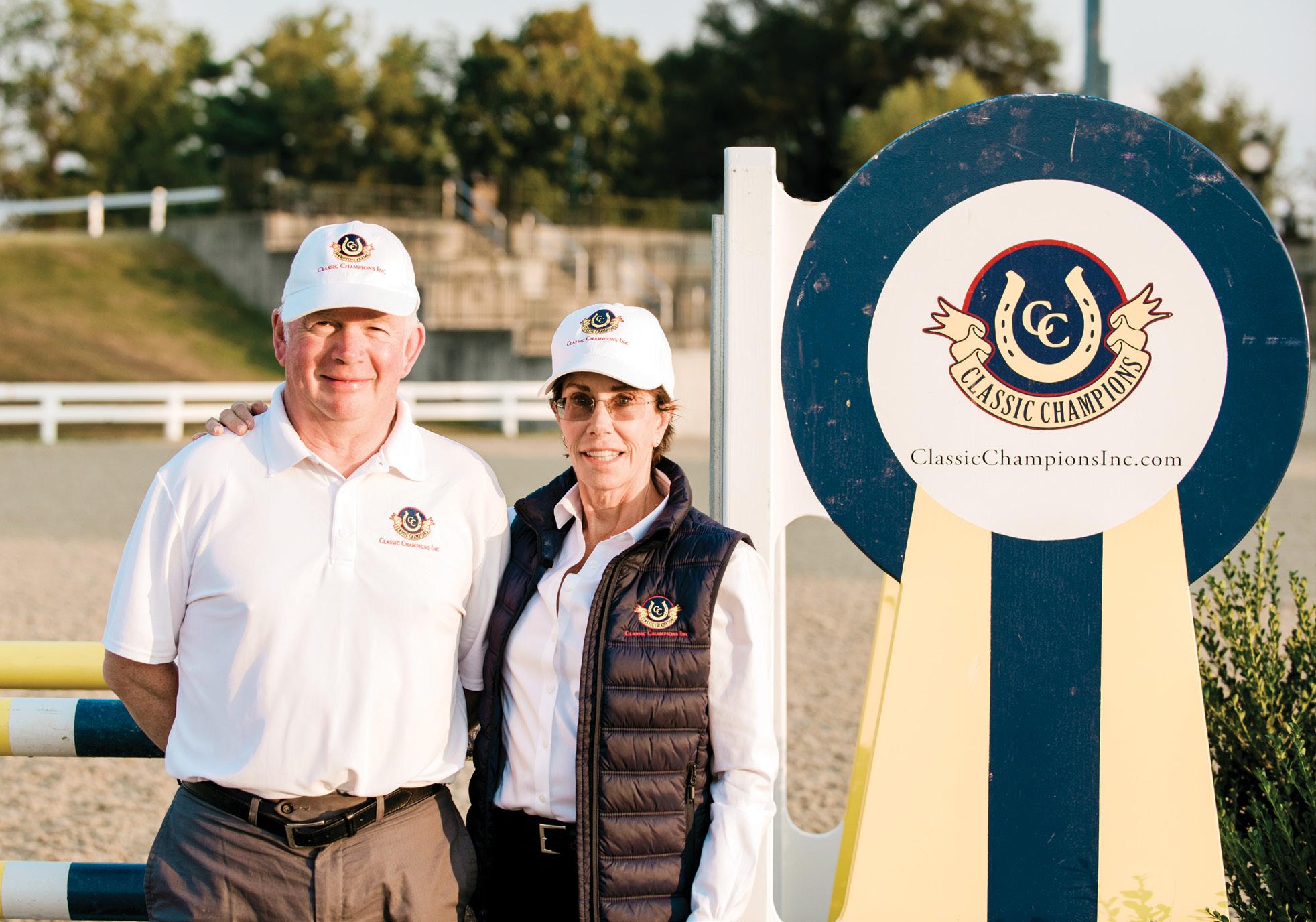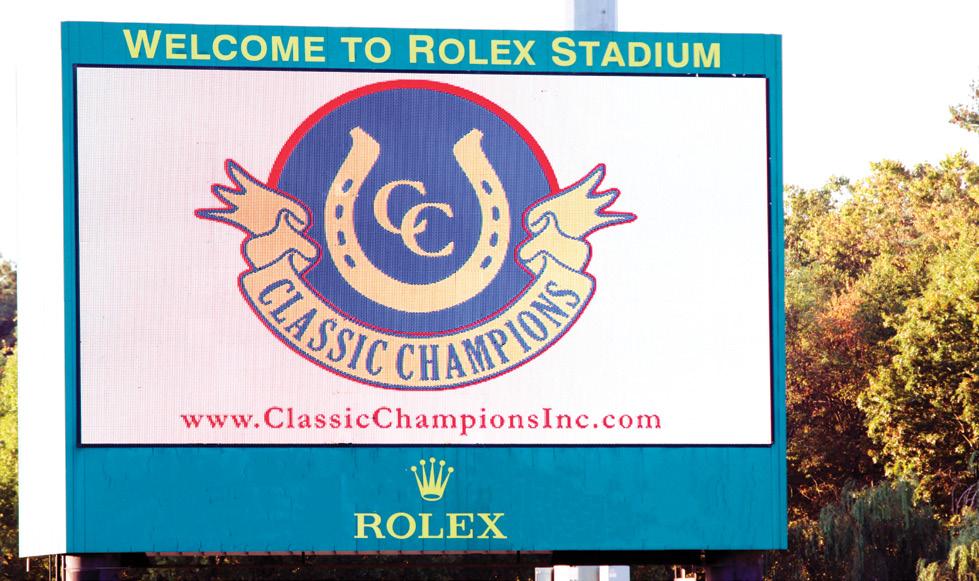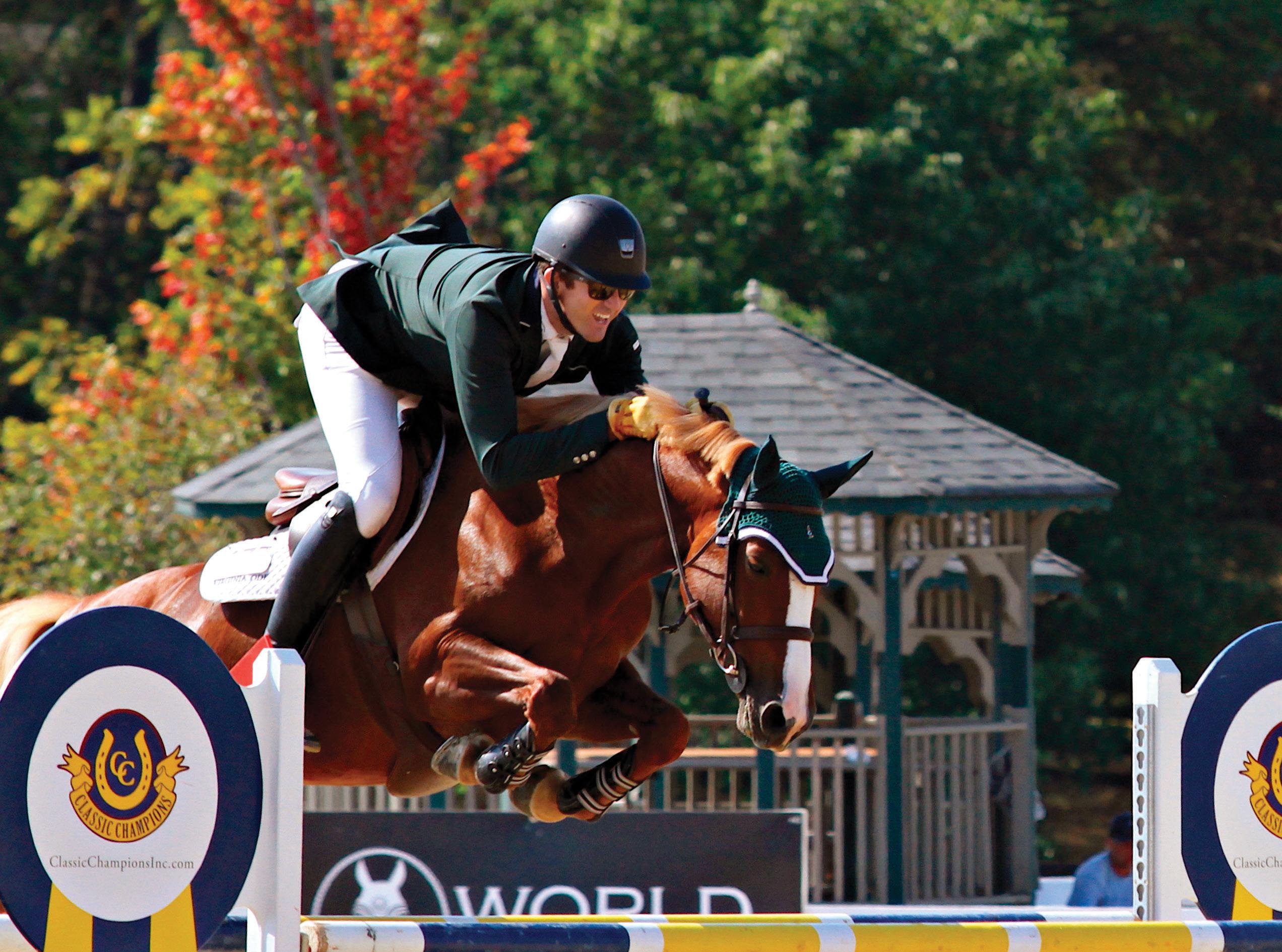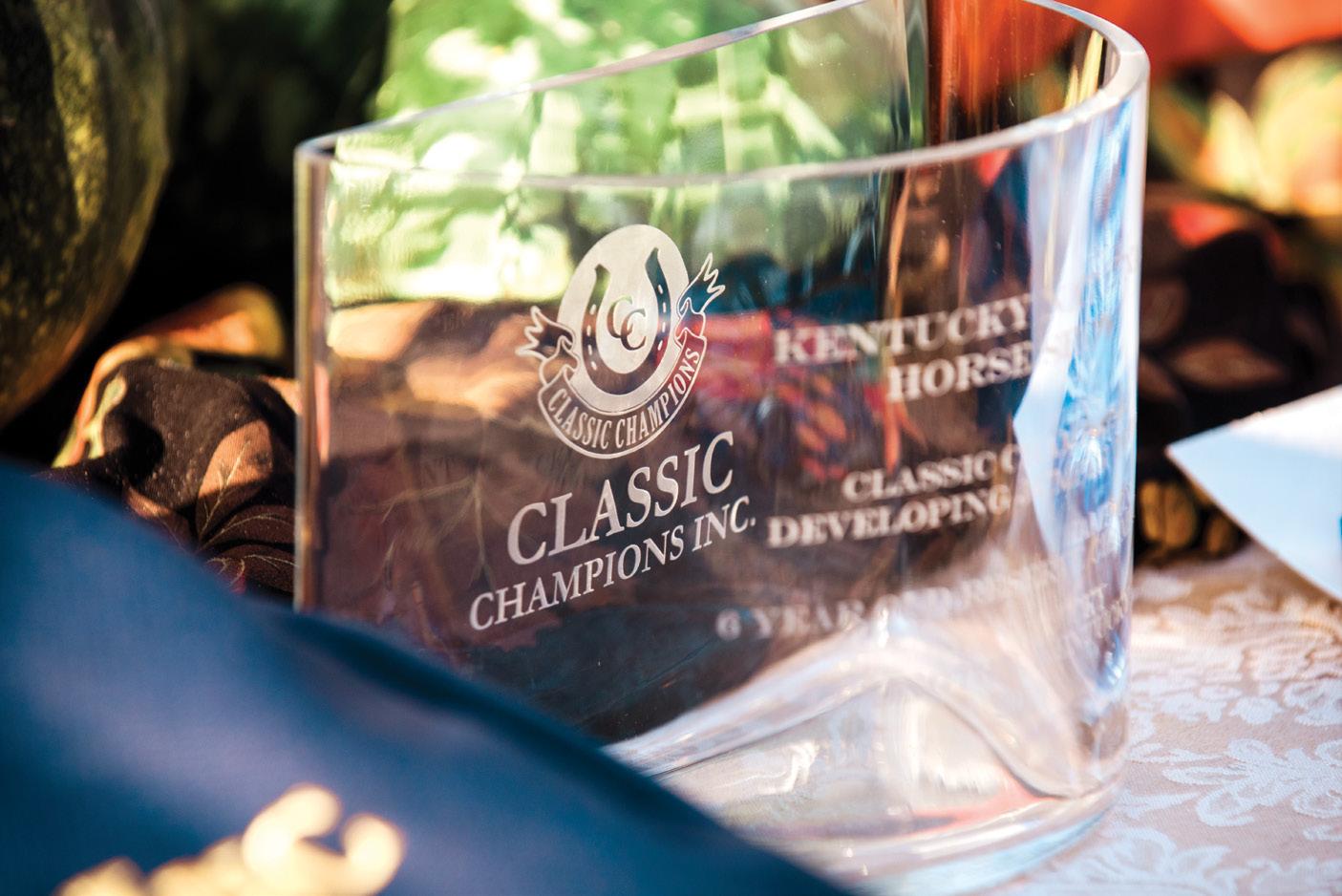
8 minute read
COVER STORY
COVER STORY
Cynthia Hampton’s Classic Champions Series: Developing Young Jumpers in America
When most people look at a jumper course, they see obstacles. Cynthia Hampton sees opportunities.
David O’Brien pilots Octavius SCF

COVER STORY
EVER SINCE the founder of Classic Champions—a Florida nonprofit organization dedicated to the education of developing young jumpers—first sat on a horse at age 3, she has been fascinated by the bond and love between horses and humans.
Education is as central for horses as it is for humans and helps deepen the bond between horse and rider, she adds. “Education has proven to help us understand what we see. In this country, we need true educational opportunities for horses in our competition arenas.”
Hampton believes the effective education of young American horses in the competition ring will provide great opportunities in the future for a new group of producers. She believes the achievement of their potential is limited by a number of factors—and she is on a mission to help that paradigm evolve.
“It is difficult and expensive to develop a young jumper in this country,” she says, noting that this has hindered the United States’ efforts to dominate the world stage in Grand Prix jumping with horses bred and raised here, as Europeans have effectively done with theirs. Her eyes were opened during her 20 years of training in France, where she observed the methodical use of the show ring to develop young jumpers. The focus there, she says, resides in the mindset that a young jumper’s competitive career should be

CLOCKWISE FROM RIGHT: Virginia ODF ridden by Charlie Jayne at the Classic Champions Young Jumper Finals in Kentucky; Tom Holden and Cynthia Hampton; The Jumbotron in the Rolex Arena at the Kentucky Horse Park.


developed in accordance with its age and inherent ability, rather than moving the horse up as soon as it shows the physical ability to jump class height.
“It’s not productive to go too fast, too soon. Your horse will be forever limited,” says Hampton. “I respect history and its proven techniques, and I am excited about ensuring our success in such ways. When the horse enjoys its job, it is most generous and feels both free and confident to express its best efforts.”
Using the European model as a guide, the Classic Champions series was founded to create an enjoyable and confidence-building structure for young jumper competition in North America. It features adapted heights, types of fences, lines and turns designed by internationally renowned course designers. Many
of them have been competitive riders themselves, and all have received education specific to the developing young jumper. “I am very excited to share this proven approach with the showjumping world here in North America,” says Hampton. Classic Champions introduced its young jumper series at shows like The Ridge, Old Salem Farm, Palm Beach Masters, and a series and final at the Kentucky Horse Park. Hampton brought in FEI course designers who specialize in young jumpers, among them Irishman Tom Holden, Olympian Frédéric Cottier, and Michel Ismalun, who once won the 5-year-old championship in France.
Ismalun, a 3* FEI course designer who created the first Classic Champions courses for 4-, 5- and 6-year-olds, says the main difference in designing courses for jumpers of different ages is “the amount of space you put between the jumps. The horse needs time to breathe.” For example, he says, sometimes the designer will incorporate a U-turn between the first and second fences to clearly separate them.
On a course for 4-year-olds, he says, a combination should never come before fence 5. “That wouldn’t be fair to the horse because it is difficult. It takes four or five jumps to set a young horse into a good rhythm,” says Ismalun.
In addition, he believes the first combination must be situated so that it is jumped in the direction of the out-gate. “That gives the horse incentive because he is alone in the ring and wants to be with the other horses,” he says, noting that the same is true with a liverpool or water jump.
FEI 4* course designer Cottier is like-minded. “It’s an educational system, so the way to design courses for young horses over three days should be completely different,” says Cottier, who believes it’s crucial to present young horses with flowing courses that incrementally build.
Many years of experience taught him that the first class should be more inviting than the second, particularly in an impressive arena. When it comes to ages, he says, “The first day, especially for a 5-year-old, has to be like a promenade over the arena. Six is a little different, and seven is completely different.” During her years of training and competing in France, Hampton came to realize that young horses have distinct needs in reaching their potential over fences. “They need time to think, compute and breathe,” she says. They need to feel their rider’s love.”
She notes that in Europe, jumper competition season opens with classes for 4-year-olds that encourage the horse to go forward over small natural obstacles and have fun. At 5, competition becomes increasingly more technical as the season progresses.
“The 6-year-old mares jump the open water all three days consecutively. The final feels like Aachen!” she says.
The challenges presented at the Classic Champions Developing Jumper Tours are tempered by the concerted efforts of course designers to make competition enjoyable for young jumpers.
“As in Europe, they emphasize the relationship between the rider and the horse,” says Hampton. “That’s what creates a winning partnership.”
That realization hit home when a young mare she owned, Kismet 50, competed stunningly well under Christophe Escande, Hampton’s trainer in France.
He brought the horse along after she acquired her as a 5-year-old. Kismet had only competed in three local classes in Belgium. Hampton remembers that the mare, sired by Kannan, “showed exceptional strength, both physically and mentally, from the moment we first saw her. We put her into the young

—CYNTHIA HAMPTON
COVER STORY

—DAVID O’BRIEN, SPY COAST FARM
jumper events in France, and she steadily evolved into a first-class athlete.”
Kismet’s proper preparation became apparent during her first round of competition at Fontainebleau. As she approached a turn to a jump, a water cannon accidentally went off. Unlike the usual horse of her age, she did not flinch. Rather, her focus actually sharpened, recalls Hampton.
“She calmly studied the distraction and turned normally to measure her approach to the next obstacle. Without missing a beat, she maintained her rhythm and flew over the jump,” she says.
Kismet qualified for the 5-year-old finals, but Hampton and Escande elected not to enter her. “Finals are emotional and physical stress for a horse,” says Hampton. “We knew the mare would develop a great deal more in the following competition season, so we decided to save that trial for her sixth year.”
As Kismet was coming 7, Hampton sold her to Olympian Meredith Michaels-Beerbaum, who was ranked number one in the world at the time. The pair went on to achieve tremendous success at the highest level of show jumping across Europe.
Holden, the Irish FEI 3* course designer who has built courses for the Irish Young Horse Championships at Dublin Horse Show for many years, joined Cynthia to serve as vice president of Classic Champions. He He designed the Classic Champions courses at the Deeridge Palm Beach Masters in Wellington, FL, in 2018 and at the finals at the Kentucky Horse Park in 2019. He believes there are many fine American course designers who incorporate European principles into their courses.
Holden says his courses for Classic Champions include elements of those used in his home country. “The courses we design in Ireland largely take into consideration what one would expect of a reasonably trained and experienced 5-year-old. We recognize and adjust for the fact that it’s not a 10-year-old going over these courses, and we don’t expect the same abilities from a 5-year-old,” he says. “The key is to balance the level of difficulty and the experience of the horse.”
Hampton underscores that “The whole picture revolves around the horse, firmly located at the very center.” She sees such efforts expanding in this country, noting that esteemed breeders such as Spy Coast Farm, Our Day Farm, Wild Turkey, Aliboo Farm, and Pomponio Ranch are “ever more dedicated to producing top-quality showjumping competitors. They are actively involved in making our sport here world class.”
Eric Navet, the fine French horseman and Olympian rider, is the ambassador for Classic Champions. Hampton knew him from her time in his home country. Navet was first noticed for his distinction in the development of young jumpers in the show ring.
“It is very important for me that all these young horses receive the best formation possible and are produced and developed in the best way. This is why I support Classic Champions,” he says.
David O’Brien of Spy Coast Farm, a frequent winner at the Classic Champions Developing Jumper series says, “The courses are friendly to the horse, and they are designed to build them up throughout the year. You don’t have to come out and jump big jumps on day one. You’re steadily building up over eight weeks to the finals. It is important to have this tour, and everyone on the Classic Champions team works together. To see all of these people work in harmony to produce horses is great.”


Kismet 50 and Christophe Escande take the water jump in the 6-year-old final at Fontainbleau.









